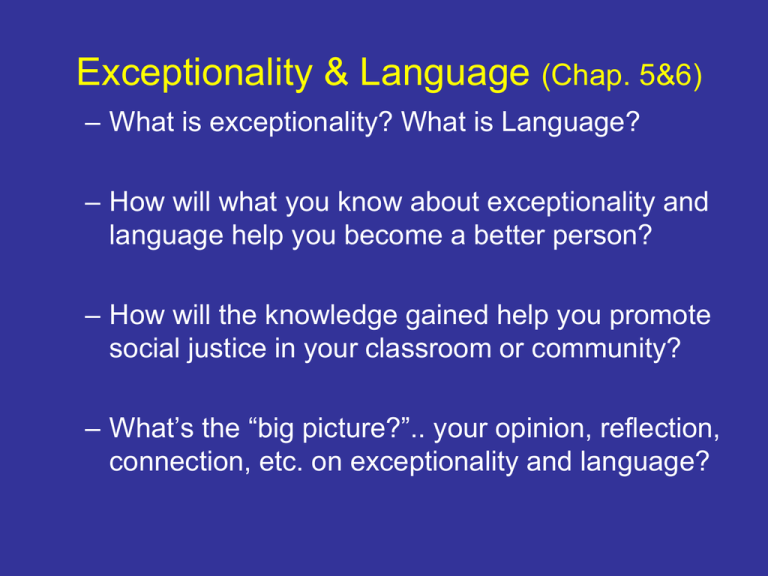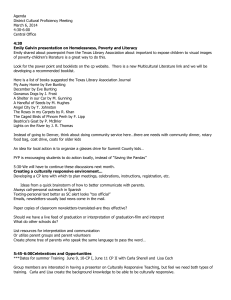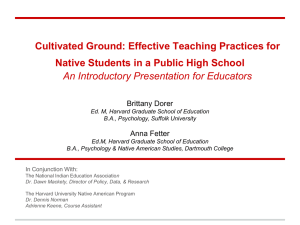Exceptionality and language
advertisement

Exceptionality & Language (Chap. 5&6) – What is exceptionality? What is Language? – How will what you know about exceptionality and language help you become a better person? – How will the knowledge gained help you promote social justice in your classroom or community? – What’s the “big picture?”.. your opinion, reflection, connection, etc. on exceptionality and language? Exceptionality & Language •Exceptionality refers to both the gifted and those with disabilities •25 million from different social groups are.. •Focus has been on disabled due to their unique social & personal needs –Hence a strong drive to identify & refer (referral or get rid) –Culture, class, gender, race, looks, personality, speech patterns influence referral process Gifted and Talented (Arends, 2009; Turnbull et al., 2006) • Show above- average talents in: – General intellect (Grasp of complex & abstract concepts) – Specific academic ability (Mathematical, Scientific & Writing) – Creativity (Insightful, intuitive, curious, & flexible) – Leadership (Advanced intra and interpersonal skills) – Visual & performing arts (master physical and artistic skills with ease) • Thus, G&T children: – Have extraordinary functioning abilities – Are able to retain a lot of information – Not focused on getting good grades Gifted and Talented – – – – – – – Have flexible thought process Have creative problem-solving skills Have large vocabularies Have extensive knowledge of a particular subject Have excellent metacognitive abilities Have high standards for performance Are usually disorganized and messy • Differentiated instruction is key: – Unconditional acceptance of children as they are and expecting them to become all they can be Disabilities Identification and Referral •ADA signed into law in 1964 to end discrimination against persons with disabilities •PL 101-336 signed in 1990 provided specifics (p. 170) •IDEA (Individual with disabilities education Act) covers educational issues •Insensitivity, apathy and prejudice has caused injustice in identification and referral (p. 177) Special education • Children of color are overrepresented in special education (1 in 3, p. 180) because: – Poverty• Leads to problems such as poor pre-natal & birth care, preterm births due to stress, and poor post-natal care – Lead Poisoning- impacts development (p. 183) – Expectations• Educators have low expectations for children of different racial, cultural heritage, class, language, etc.), hence the “get rid of” attitude- Special Education – Over referral (p. 183) • Mainly Black males from lower SES • Referral by teachers, doctors & parents is 1st step to special ed. placement • Teachers are mainly female, white & middle class • Cultural incongruity is suspect • Racial bias– Children of color are likely to be placed in low academic tracks– Why?.. Chideya p. 63) – Placement of Blacks in programs for emotionally disturbed is 50% higher than the general school population (p. 184) Special Education – Assessment issues- tests are usually culturally biased – Test are informed by white-middle class culture. Example: • It costs 1:50 each way to ride a bus to work. The weekly pass is $16.00. Which is better; paying daily or a weekly pass? – Language used is from white, & middle class culture. White-Middle-class culture • On language (chapter 6): What is, & how does it affect schooling? • Language is: – a socializing agent…p. 201 (p. 204 on circular talk) – usage is culturally determined (p. 200, 203 & CD) – neither good or bad (labels used to confer power & privilege- p. 204 – aids in identity development – a medium of interaction with society- We’re judged by our words (p. 201 & 43- color of teaching) – Is diverse (4-5K) (dialects- regional & social) & accents – affects (1st language) brain development- hence learning- p. 216 (see handout on cultural cognition) – Influences school’s & academic success (p. 219) Special Education – Unexplained issues- especially within people of color: • Blacks vs. Latinos- skin color issue?- Chideya p. 47 • Gender (Black males vs. females)- socialization issues? – Angry Black Male syndrome • A desire for homogeneity (norming) downplays obvious human differences. Educational Implications • “People are ready to believe anything, as long as it conforms to an already existing belief systems; and to be suspicious of anything that does not” ~The Monk and the Philosopher: A father and son discuss the meaning of life by Revel & Riccard, 1999~ • Educators must therefore: – know the needs of their exceptional children – know the facts surrounding identification & referral process Know the facts – Know the facts such as: • Testing confers privileges to the privileged & denies social mobility to unprivileged (Smith p. 80) • Testing is a political, social event that serves the interests of the powerful • Stereotype vulnerability affects performance negatively (Rassol, p. 214-15) • Testing will not go away due to money involved (Rasool p. 218).. Big business Know the facts • Each year 250 million standardized tests are administered in the U.S. to compare children with a “norm” (Rasool p. 38) • Current testing is a gate keeping strategy (p. 36). • Current testing is a tool of “shame” – Smith 2004- Consider the following vignette: Humiliation (Lessie Smith’s Testimony) • I always thought I would be a teacher like my mother. Since Middle School I have volunteered in my mother’s classroom and the classrooms of other teachers. I really loved helping the children. Now, I know I will never be a teacher. I have failed the CLAST (Florida teacher exam) exam three times. You know, it never occurred to me that I was not smart enough to be a teacher. I have cried a lot about what all this means. And, you know, I am embarrassed about failing the CLAST – like I said, three times now I am ashamed. I can hardly face my mother. I don’t tell anyone else though. It’s time to move on. I’m an English major now. I had to change my major from education to English my junior year. Testimony, Lessie Smith, African American student (name changed) Focus Group, October 16, 2002 Know the facts • Authentic assessment/s provide valid data about what children know or need to know because: – They are holistic- big picture – Children collaborate and cooperate – Worthwhile – Multiple audience (learners, parents, administrators, community, etc.) – Eliminate racist and sexist elements inherent in modern testing – Cultural influences on learning is considered Know the facts • Becoming culturally responsive is essential because such educators use words and labels that: – Value people – Promote self-concept – Inspire people – Empowering (Smith p. 58) – That are well thought-out (Smith P. 59) Know the Facts • Culturally responsive educators are: – Good teachers- believe in democracy and justice (Obiakor p. 97). – Prepare for, & address possible challenges such as: • Personal • Institutional • Societal • Epistemology/knowledge/ways of knowing Know the facts • Culturally responsive educators: – Appreciates the notion that culture influences learning, thus provide “culturally matched L.E.” (case 25 on p. 121) – “The question is not necessarily how to create the perfect “culturally matched” learning institution for each ethnic group, but rather how to recognize when there is a problem for a particular child and how to seek its cause in the most broadly conceived fashion. Knowledge about culture is but one tool that educators may make use of when devising solutions for a school’s difficulty in educating diverse children “Lisa Delpit, Other People’s Children” (Smith 1998- p. 43) Know the facts • Culturally responsive educators: – Strive for congruity between teacher’s and learners’ culture = Cultural synchronization (Smith, p.53) – Contextualize learning (influence of cultural ecology; patterns and behavior) p.145 – Eradicate the mismatch between home & school culture – Use “cultural capital”…student’s cultures & strength to build bridges for school success (p.52) Know the facts • Culturally responsive educators: – Have in-depth knowledge of home culture and “high culture”- empirical presentation of a groups’ cultural identity – Affirm capital culture as integral and valued tool in the school environment – Are artists who view students and learning differently (p.54 - 56) – Use effective teaching strategies • Teamwork vs. didactic- teacher talk & seatwork (p.60) • Cross-age peer teaching & role modeling – Use inclusive non-stereotypic primary resources Know the facts – Culturally responsive educators: • Involve the community • Teach learners to think critically about issues of social justice and privilege • Bring multiple voices/view points/positions in the discourse • Teach children critical thinking skills (justice) • Use multiple standpoints/positions- dominant and non-dominant (Smith, 1998; Rasool & Curtis, 2000; Gay 2001). Know the facts • Culturally responsive educators: – Care • “Children do not care how much you know until they know how much you care” – Love • Teaching all children well is very simple… Really, it takes loving them all. – Meet their student’s needs Religion & Age (Chap. 7&9) • What is Religion? What is age? – What do you already know about Religion & age? – How has these chapters helped become a better person? – How will the knowledge gained help you promote social justice in your classroom or community? – What’s the “big picture?”.. your opinion, reflection, connection, etc. on exceptionality and language?



